Kids Toy Organizer And Storage Bin
The Best Toy Storage, According to Professional Organizers
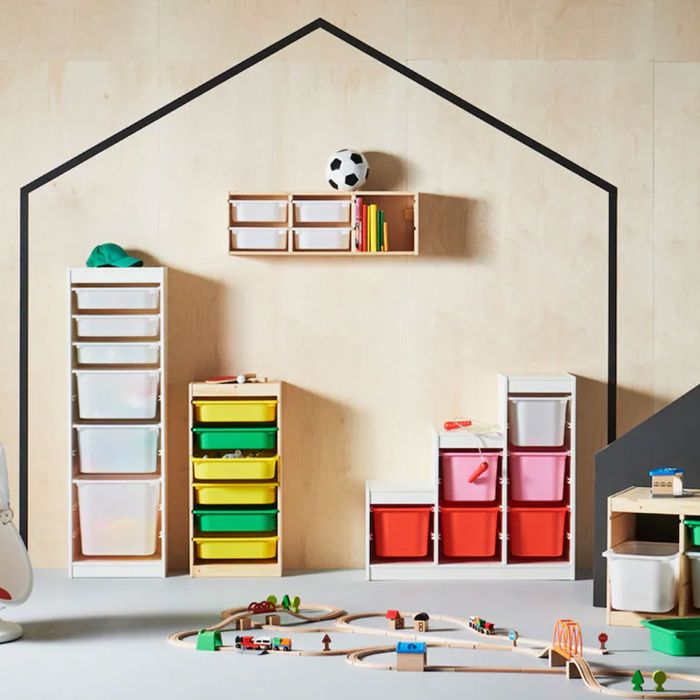
Ikea's Trofast storage units made our list because of how adaptable they are. Photo: Retailer
Kids require a lot of gear — strollers, car seats, cribs — from day one. As they get older, they start to accumulate a lot more, especially toys. Before you know it, their stuff begins to overtake every part of the house, try as you might to keep up with cleaning up after their messes. Many of the professional organizers we talked to say that getting little ones involved in tidying can help when it comes to those messes. As Kadi Dulude, the owner of cleaning and organizing company Wizard of Homes, explains, "Teaching your kids the importance of being clean and organized is super important — not only because your home is nicer, but that is also how you bring up responsible adults who take care of their space and who respect their surroundings."
Professional organizer Katy Winter, a mother of three, says kids as young as 2-years-old can begin to pitch in. "Give them a small task, like putting all the blocks away," she says. "Being specific gets them used to participating." Another way to keep clutter in check is to "be intentional about cycling out toys that have been outgrown, broken, damaged, and not played with anymore — or ever," according to professional organizer Tanisha Lyons-Porter, another mom of three. Still, the toys they hang on to do have to go somewhere. To find the best stuff for storing kids' toys, we spoke to Dulude, Winter, Lyons-Porter and nine more professional organizers about the solutions they recommend. Their suggestions range from storage units to shelves to baskets to bins to rolling carts, so there's something for most everyone — and every toy. The recommendations are arranged by style of storage and, where applicable, each category begins with any storage that came up the most.
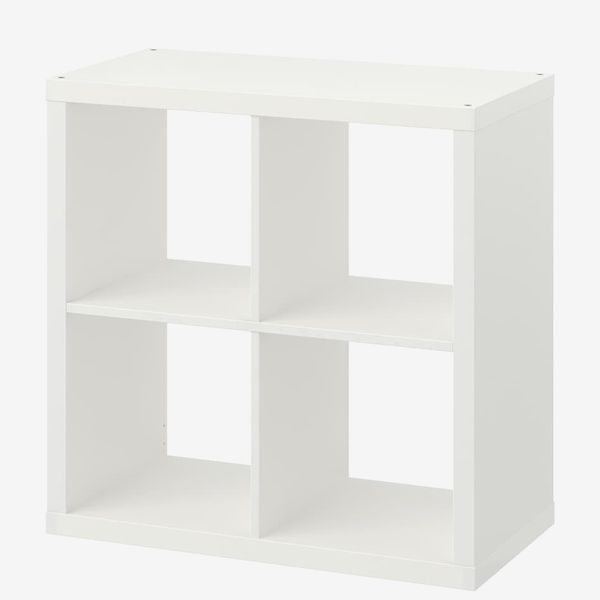

Many of our experts turn to Ikea for its affordable line of storage units and shelving for organizing toys. Three of the organizers we spoke to — Winter, Boston-based professional organizer Corinne Morahan, and Natalie Schrier, the founder of Cut the Clutter, recommend the Kallax cube shelving unit for its versatility and basic (in a good way) look that they say will blend in with any existing décor. Schrier told us the unit "is versatile enough to keep in a living or family room." And as Morahan notes, "You can put baskets in if that's your aesthetic, or keep it more minimal." To those who want baskets, Lyons-Porter likes the Kuggis containers; this size will fit snugly within the Kallas's cubes.
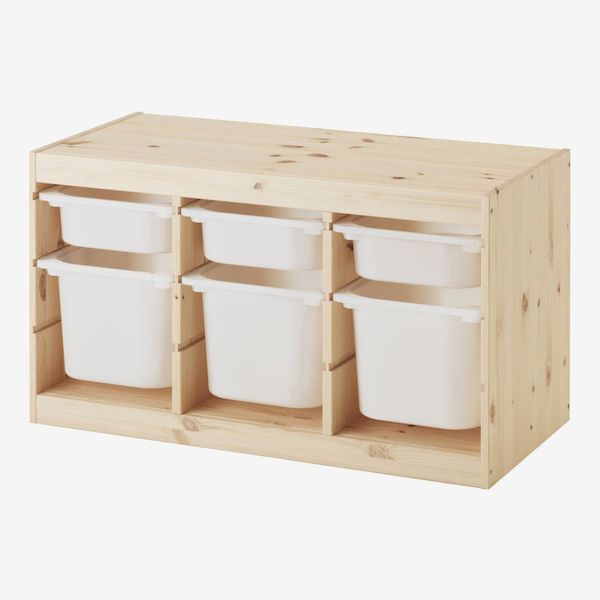
Ikea's Trofast toy storage system is another popular choice: both Lyons-Porter and Morahan recommend it for how adaptable it is. Unlike the Kallax, which is more of a shelving unit, the Trofast is essentially an open dresser that you can fill with three different sizes of drawers — slim, double-height, and triple-height. Morahan explains that this gives you the ability to better store toys of various sizes in the same unit because you could have a row of slim drawers that she says are ideal for Legos above a row of deeper ones for stuffed animals. Lyons-Porter calls the storage drawers "perfect for categories of items that are 'grab-n-go'" and notes they "can easily be labeled with a picture of the item or words." You can get the particleboard units in two different finishes; shown in a solid pine, it also comes in white (for $61). This particular model comes with three slim drawers and three double-height drawers, but you could swap all those out for three triple-height ones if you want because you can buy individual drawers (in different colors, too) a la carte. The Trofast range also includes lots of other units depending on what your space may require.
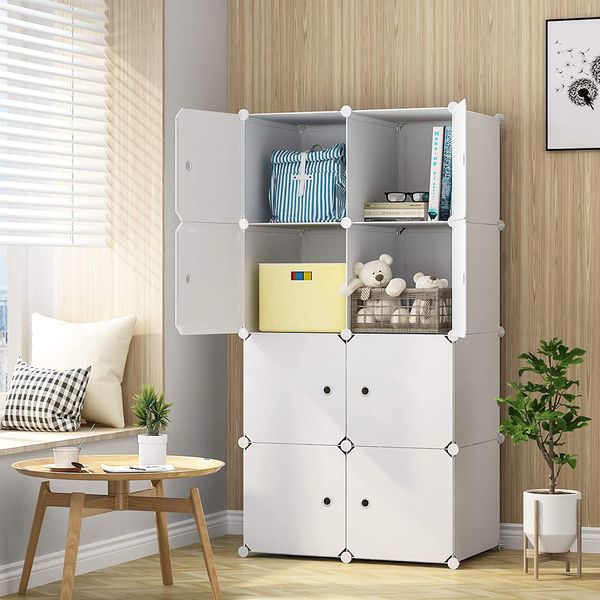
Professional organizer Rolanda Lokey recommends these modular storage shelves that come in various sizes, starting from an eight-cube unit (shown here) to one with 20 cubes. As she explains, it's a great option for "parents who do not have space for a separate playroom" because the unit comes with doors for each cubby that are detachable. This, Lokey says, "allows parents to combine function and design by designating certain spaces on the shelf for concealed storage and others for displaying vases, art pieces, or books by just removing the doors."
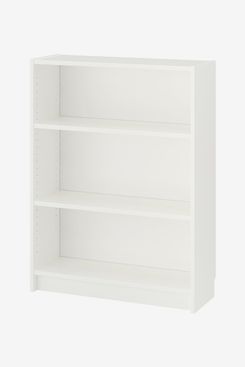
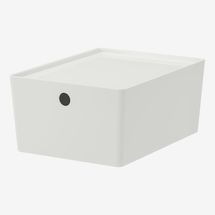
Lyons-Porter is also a fan of Ikea's Billy bookcases because they can be used alone to store books (and other things) or be filled with bins if you want even more organization. The bookcases, she adds, "mimic the organization of a school setting" because you can "make certain items accessible and in-reach and others not as accessible and hidden on higher shelves." Like the Trofast and Kallax systems, the Billy bookcase comes in many different sizes and configurations. This Kuggis lidded bin would fit nicely on the unit's shelves, but Lyons-Porter notes the bins are stackable, so you could just buy a bunch and use them on their own, too.
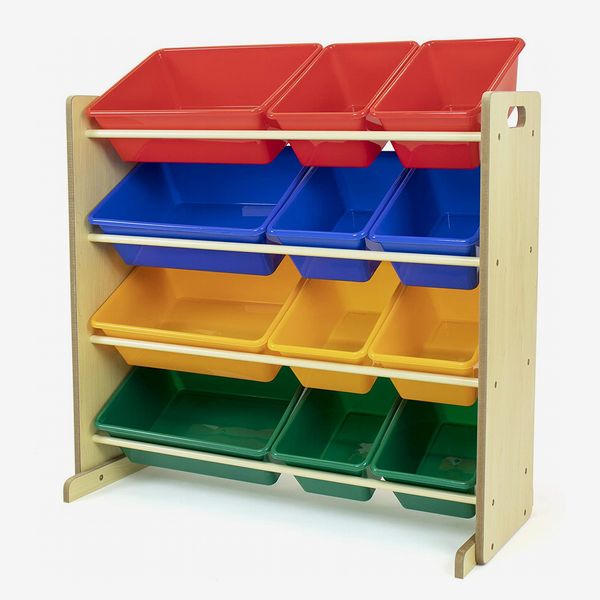
Lokey says it's important for parents to consider their child's emerging habits and organizing preferences when choosing toy storage. "Some kids are great at putting things away, while other children are often still developing the basic habit of tidying," she explains. The latter group, she says, "may be less inclined to use storage products that require opening and closing boxes or returning items to labeled shelves because children may perceive that to be a great effort." She recommends this unit to anyone with very young children who are just learning the concept of organization or parents of kids with special needs. Its "color-coded, open bins in primary colors are great for teaching kids how to sort and categorize while using foundational skills they are likely learning as a part of their primary education," Lokey says.

Lokey also told us about this organizer that might appeal to anyone looking for a bit of a twofer. It has a standing unit with three open bins and a larger open chest on wheels that can be moved around. She says the bins are great for smaller toys — or the "inevitable stray Lego or action figure parents tend to find on the floor from time to time." The rolling chest, meanwhile, is better for larger electronics or musical instruments. "The open containers on top keep smaller toys accessible while you can stash larger items away and out of sight," Lokey concludes.
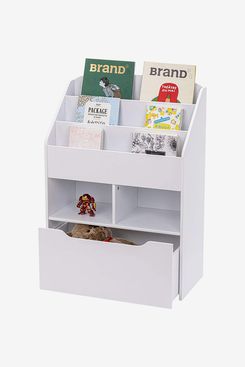
Another unit that can hold books and toys is this organizer that has a bookstore-like display area on top, open shelving in the middle, and a pull-out chest at the bottom. Lokey told us about it, explaining that "combo bookshelf–toy storage solutions work very well for confined spaces."
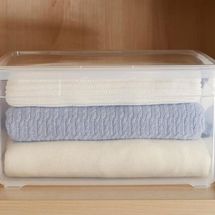
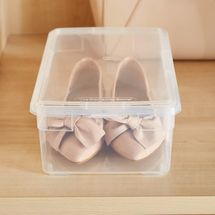
Photo: Courtesy of Retailer
In addition to the bins that pair with the larger storage units above, the experts also told us about lots of standalone options that folks who don't need a full unit might prefer. Unsurprisingly, a lot of the organizers love the Container Store and its line of storage items. Winter's go-to products are the brand's sweater box and shoe box: "Ninety percent of all toys will fit in them," she says. "I start every organizing project with these." She particularly loves how well they stack. "They have a lid, so you can use vertical space by stacking them," Winter explains, adding that these will pretty much fit on any shelves you may already have in your home, too.
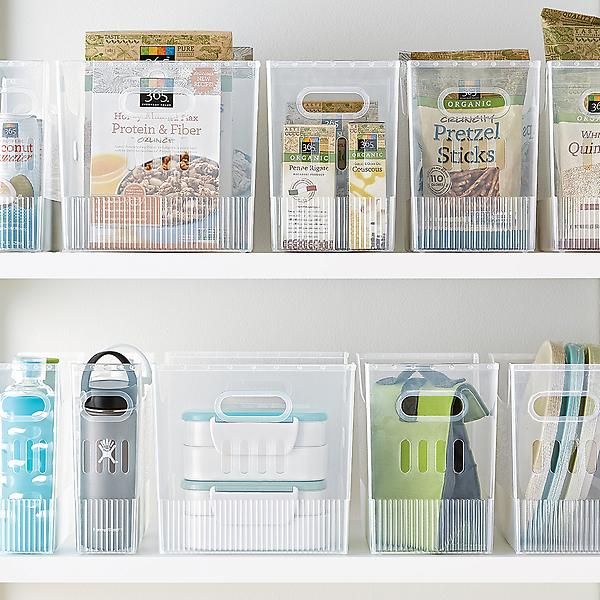
Lyons-Porter is another Container Store fan. Her favorite bins are multi-purpose ones that come in four different sizes (the smallest starts at $4 and the largest goes for $6). "They're translucent, easy to access, sturdy, reasonably priced, fit great in a cabinet or on an exposed shelf, and are perfect for little hands," she says.
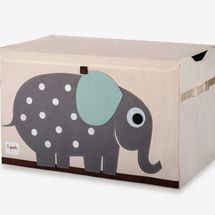
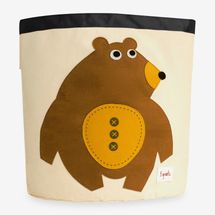
Little animal lovers will get a kick out of these toy chests and bins decorated with elephants, bears, hedgehogs, or rhinos. They're favorites of both Nicole Abramovici of Genius Organizing and organizing expert Christina Giaquinto, who says, "I am a firm believer in storage being aesthetically pleasing but also functional, and this accomplishes that." Giaquinto adds that the bins are "very sturdy, so they hold toys really well." The zoo critters are also a visual cue to remind kids these are where to keep toys like stuffed animals.
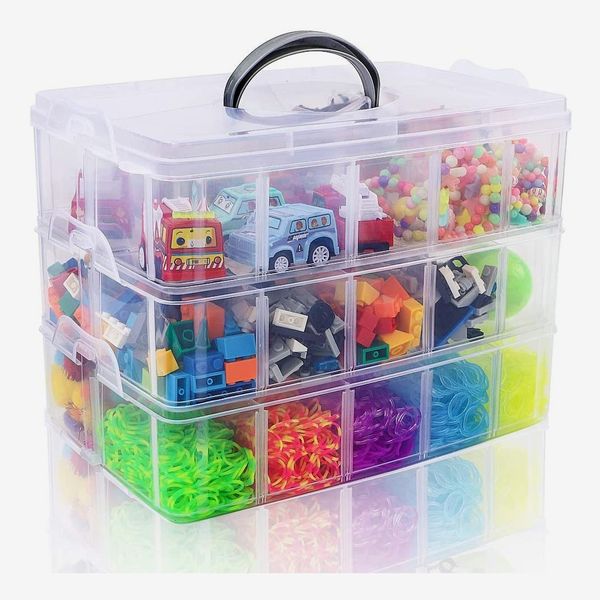
Keeping track of tiny figurines and accessories can be a headache. According to professional organizer Daniel Loya, an organizer like this is "essential for keeping all of the small odds and ends off of the floor." It consists of three layers that can be divided up into 10 compartments each, but the partitions used to divide the layers are removable and adjustable. The layers conveniently snap onto each other, too making it easy to get rid of any if you don't need all three. A handle on the top makes it easy to transport.
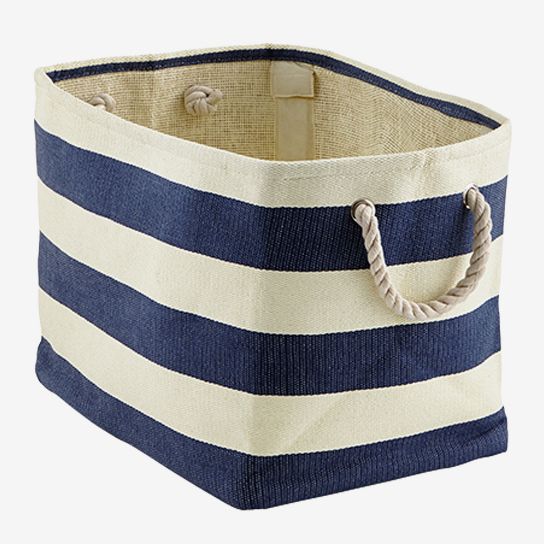
Attractive enough for any room (and more than just toys), organizer Mary Cornetta, the founder of Sort and Sweet, uses these baskets at her own home to clean up when playtime is over. "Any toys that they dragged out to the main living area get thrown in a basket," she explains.
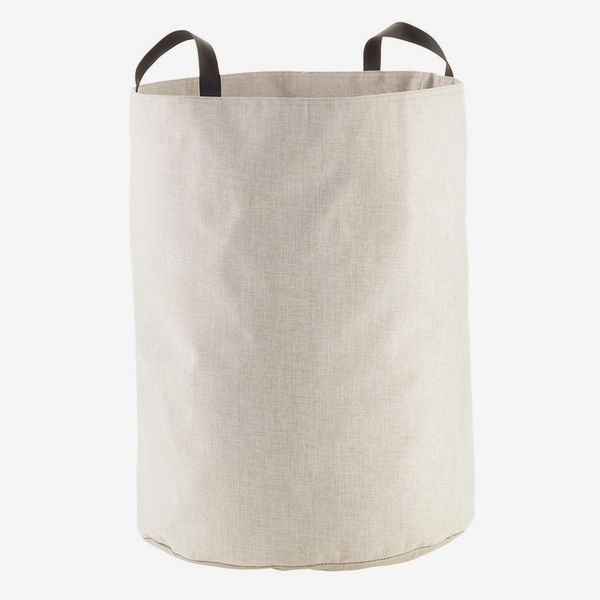
A bit taller than the above basket is this cylindrical one that Schrier recommends for stuffed animals or large balls. Echoing Lokey, she says it's great for younger kids who find that "drawers are not necessarily user-friendly" because the open top allows them "to drag and dump" their toys when it's time to put them away.
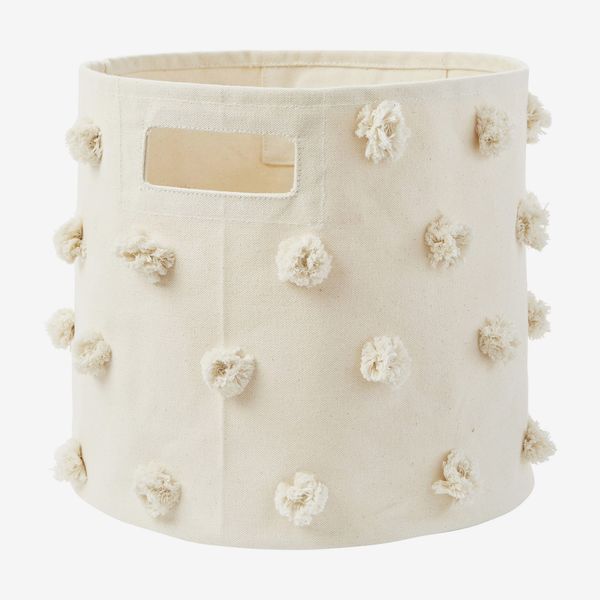
For another bin that parents won't mind looking at, Sylvana Ward Durrett, a co-founder of Maisonette, recommends this pom-pom adorned one from Pehr. "When you're done using them for your kids, they're perfectly appropriate for your apartment as well," she says, making them more worth the investment. Plus, the bins are foldable, so you can easily tuck them out of sight should you ever need to store your storage.
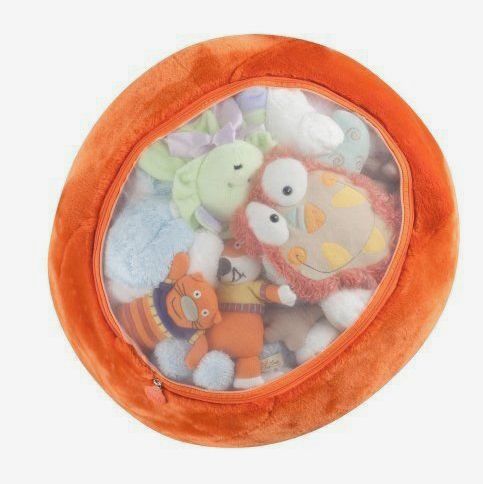
This nifty storage comes recommended by Patty Morrissey, an organizer certified in the KonMari method. When filled with stuffed animals, she explains that it can actually become extra seating. "These hold a ton of stuffed animals and double as ottomans," Morissey says. "They look attractive in children and family spaces."
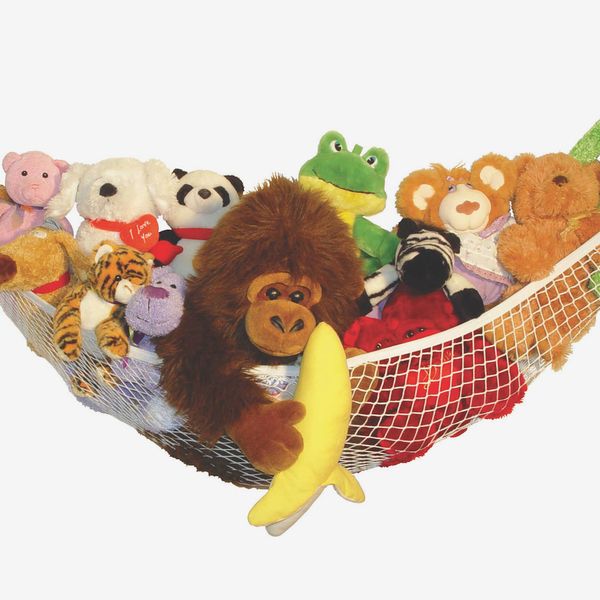
Technically not a shelf, this hammock essentially functions as one and would be a way to keep favorite teddy bears and other stuffed animals on display in a kid's room, too. It comes recommended by Abramovici, who says "kids can think of it as a game to toss toys into the hammock — motivating them to clean up." Off-the-ground storage like this, she adds, gives "parents more control over which toys can be in play at any given time, since all the toys aren't at kids' reach."
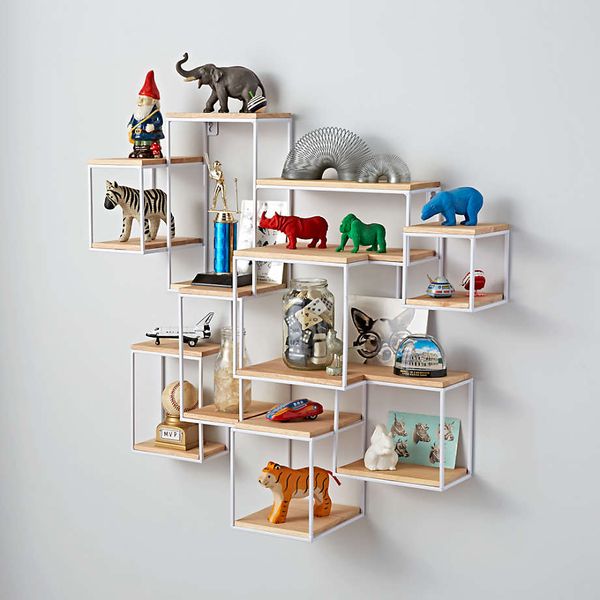
Loya admits this shelf is less for storage than display, but says it's a rather attractive way to make any special toys appear even more so. He calls its design "more visually appealing, with an artsy edge," adding that the sturdy surfaces of varying size, shape, depth, and height "enable it to fit all types of toys."
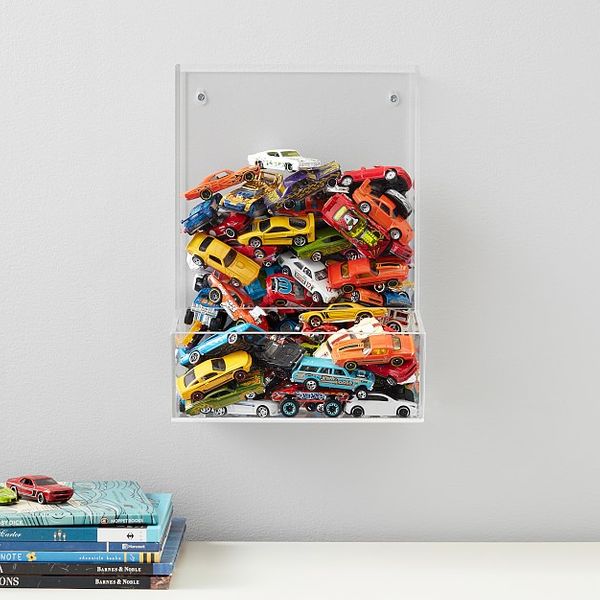
Another option for displaying (and storing) toys is this acrylic dispenser that Loya says is "great for small spaces because it utilizes vertical space." Not only will it keep small toys like cars and figurines organized, the dispenser mechanism "makes it fun for kids to retrieve them," he explains. Loya adds that its see-through nature makes the storage kind of cool-looking, too, when "children store similar items together" like the cars shown.
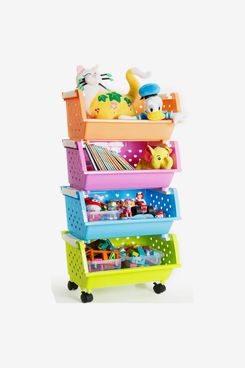
"Rolling toy storage is great because sometimes kids play in multiple areas in the home," explains Lokey, who recommends this colorful shelving system with stackable bins. "Moving the fun to another room minimizes cleanup and allows parents to supervise while cooking, cleaning, or working from home."
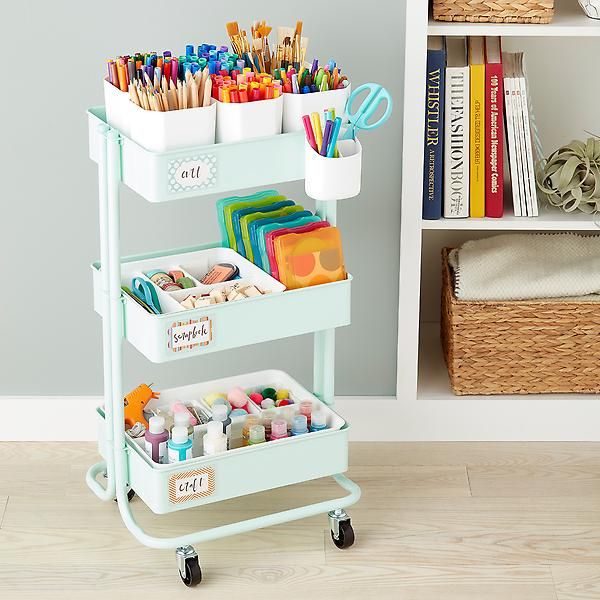
Winter is also a proponent of using rolling carts, especially for arts and crafts. "A lot of people do artwork in the kitchen or in a different area, and some parents don't want their kids having access to the Play-Doh or to have art supplies everywhere," she says. Her favorite rolling storage is The Container Store's three-tier rolling cart. To organize it, Winter suggests using magazine holders for coloring and activity books and mason jars for crayons, markers, and colored pencils. The Container Store also sells different containers and compartments for the cart if you prefer stuff that matches.
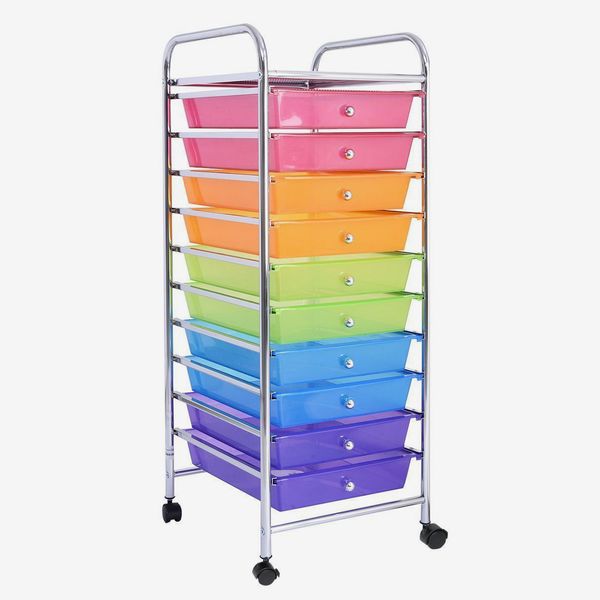
Morrissey likes this ten-drawer rolling cart for storing Legos. "The long, shallow drawers make it easier for kids to find the exact pieces they're looking for when building their own creations," she explains, adding that the colored drawers can also guide kids where to put different color pieces.
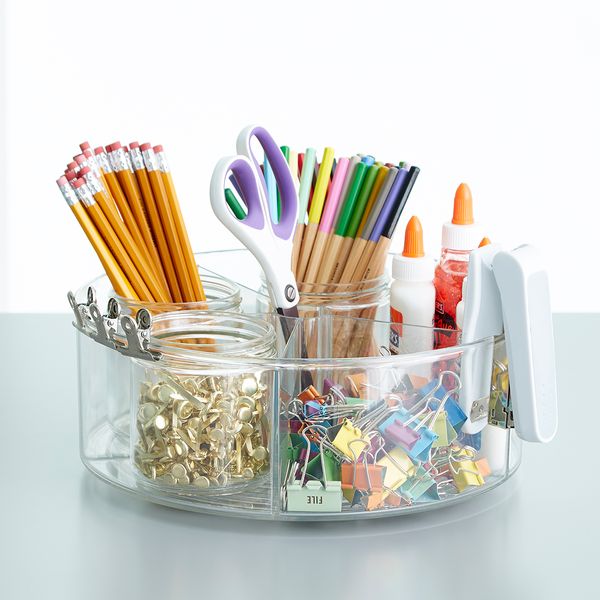
One of Winter's favorite ways to organize art supplies like markers, crayons, and colored pencils is to use a lazy Susan, like this one that she recommends. "Kids like it because they can just grab whenever they want and start coloring," she says.
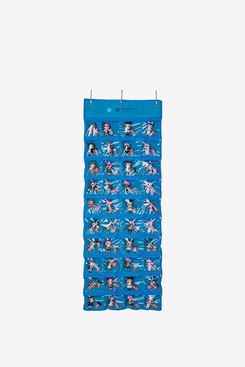
As Loya notes, you can also take advantage of a door to keep toys out of the way. "An incredibly affordable way to store toys is to use an over-door-hanging organizer like this," he says, calling it "a real space-saver" and adding it can also go "on a wall or in a closet." Plus, "with 40 clear pockets, it's easy to find any toy," he says.
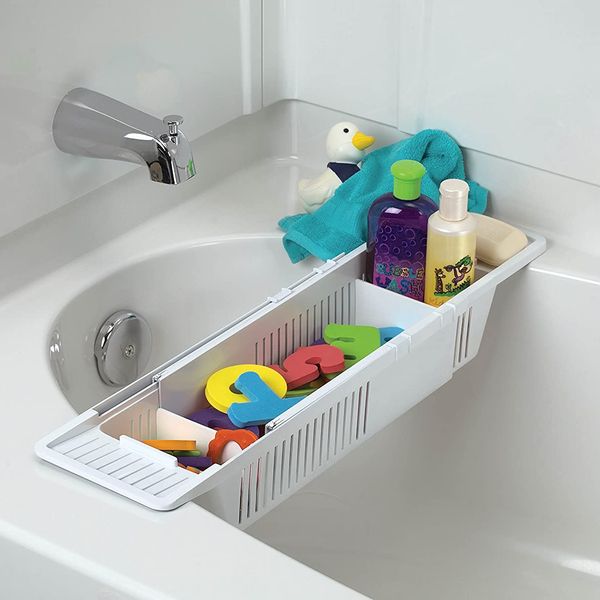
Bath time comes with its own set of toys, which is why you might want to get something for the bathroom. "This adjustable bath toy organizer fits most tubs and keeps toys and bath essentials contained and within reach while in use," says Lokey. "When bath time is over, the organizer can be removed and stored in a closet or on a shelf, making it super-convenient for shared bathrooms."
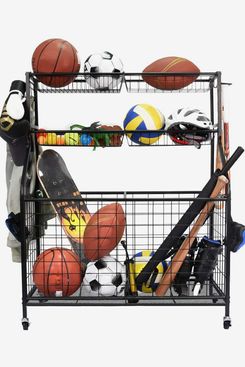
For older kids who play sports, ball bins and equipment organizers can make life easier, according to Lokey. She says storage like this open rack will make it easy to spot what you need, allowing parents "to quickly assess when it's time to purge outgrown bats, damaged racquets, deflated balls, and other items kids no longer use." Another benefit of a sports rack is that it can be used by adults for organizing their own gym gear, as Strategist contributor Alex Olivo pointed out.
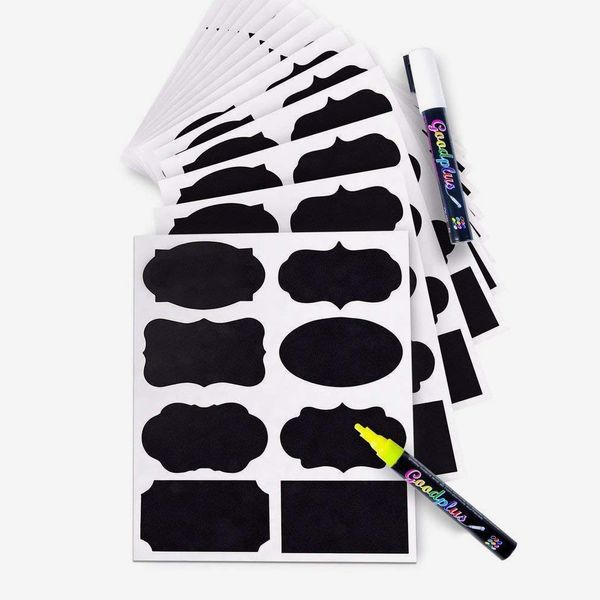
Whether you're using bins, shelves, or boxes, nearly all the organizers we spoke with recommended labeling your storage so kids know where everything goes. Morahan says labeling "really helps kids get excited to put things away in the right spot." Cornetta prefers chalkboard-style stickers so labels can be erased and rewritten when kids grow out of certain toys. For little ones who aren't reading yet, try drawing a picture on the label or sticking on a Polaroid photo.
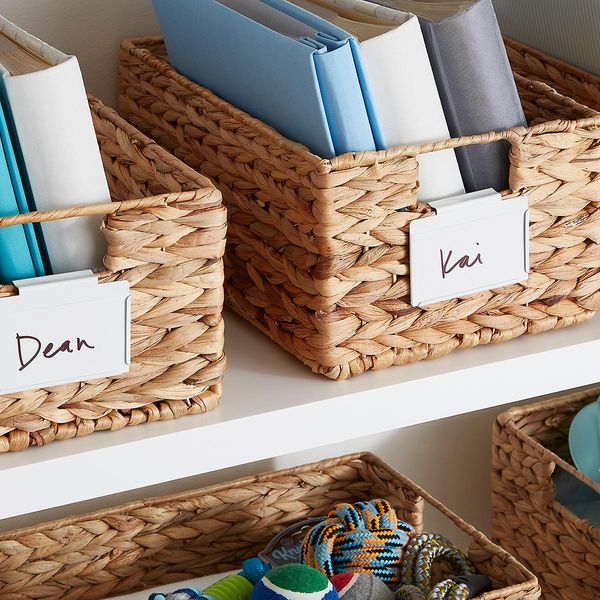
Winter is a fan of using clip-on labels for bins and baskets, like these from the Container Store. She likes writing out labels in big block letters, adding that it helps with letter recognition.
The Strategist is designed to surface the most useful, expert recommendations for things to buy across the vast e-commerce landscape. Some of our latest conquests include the best acne treatments , rolling luggage , pillows for side sleepers , natural anxiety remedies , and bath towels . We update links when possible, but note that deals can expire and all prices are subject to change.
Every editorial product is independently selected. If you buy something through our links, New York may earn an affiliate commission.
Kids Toy Organizer And Storage Bin
Source: https://nymag.com/strategist/article/best-toy-organizer-ideas.html

0 komentar:
Posting Komentar